“The Arnolfini Portrait” by Jan van Eyck – A Mirror of Mastery
The Arnolfini Portrait (1434) by Jan van Eyck has been a widely debated work of art and one that still elicits curiosity and questions today. Who are these two people and what did the artist really portray? Read more about this oil painting by one of the masters of oil painting of his time below!
Contents
Artist Abstract: Who Was Jan van Eyck?
Jan van Eyck was born around the year 1390 in the city called Maaseik in the Limburg province of Belgium. He died on July 9, 1441, in the city of Bruges, also in Belgium. He was regarded as the “Father of Oil Painting” because of the high level of naturalism/realism he painted. Minimal information exists about his life, but it seems he was from an artistic family.
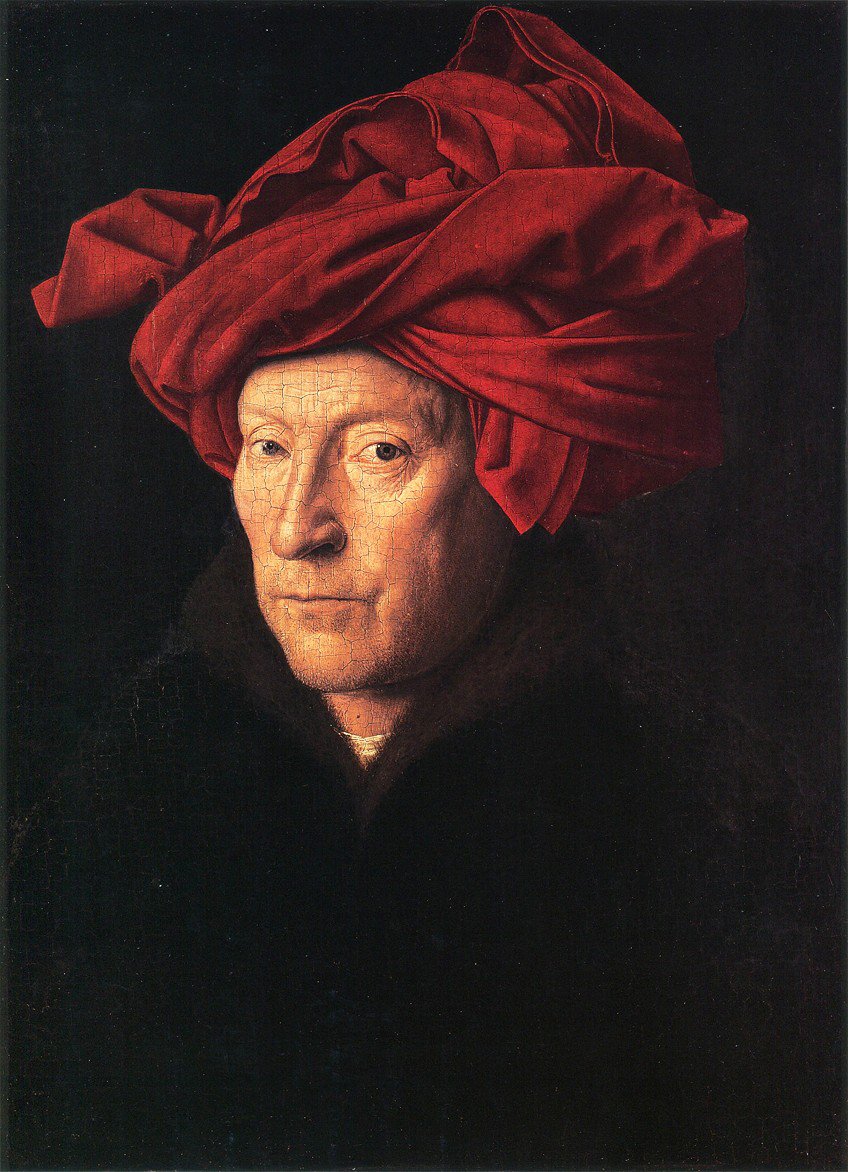
Reportedly his siblings, who have been recognized as possibly being Margareta, Hubert, and Lambert, were also painters. Some also suggest he apprenticed, and collaborated on artworks, with his brother, Hubert. He also received various commissions and was a court painter for Philip the Good, the Duke of Burgundy.
Some of the artworks attributed to Jan van Eyck are The Ghent Altarpiece (1432), which he painted with Hubert van Eyck, Portrait of a Man (1433), and Dresden Triptych (1437).
The Arnolfini Portrait (1434) by Jan van Eyck in Context
| Artist | Jan van Eyck (c. 1390 – 1441) |
| Date Painted | 1434 |
| Medium | Oil on oak |
| Genre | Portrait/Genre painting |
| Period/Movement | Early Netherlandish |
| Dimensions (Centimeters) | 82.2 x 60 |
| Series/Versions | N/A |
| Where Is It Housed? | National Gallery, London, United Kingdom |
| What It Is Worth | Bought in 1842 by the National Gallery for 600 Guineas |
In the following contextual analysis, you will read more about the wealthy couple portrayed in the Jan van Eyck Arnolfini portrait. The analysis will also discuss who the couple was and the meaning of the portrait, which many have believed was related to the Arnolfini marriage.
Some of the questions explored in this article will range from, “The Arnolfini Portrait is part of which period in art?” to “What does the dog in The Arnolfini Portrait symbolize?”.
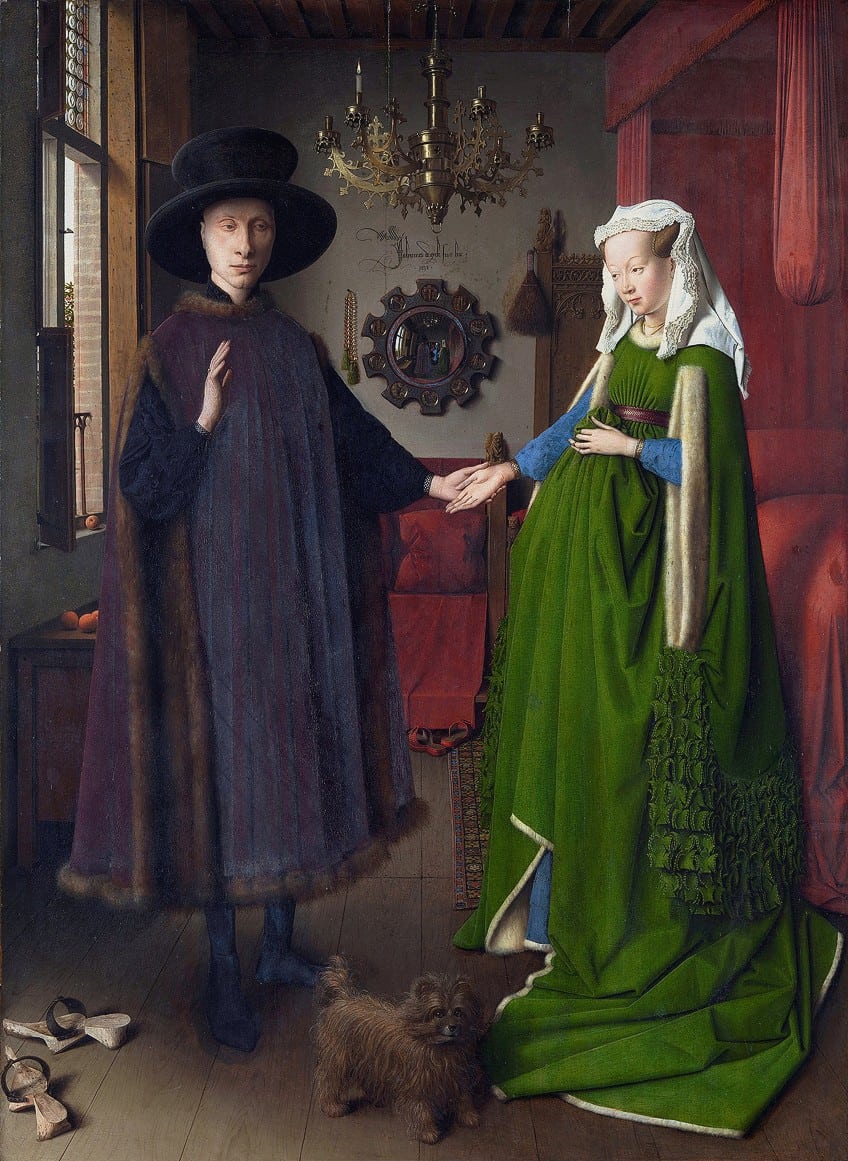
A formal analysis will discuss what is occurring in the painting and its stylistic details, taking a closer look at Jan van Eyck’s techniques and how he composed the art piece with reference to the elements of art. It is important to note there are extensive scholarly theories about who the people in this painting were and what the meaning of it might have been. Therefore, this article will explore some of the primary concepts related to The Arnolfini Portrait, with encouragement to you, the reader, to delve deeper into its many meanings and mysteries.
Contextual Analysis: A Brief Socio-Historical Overview
The Arnolfini Portrait by Jan van Eyck is a treasure trove of artistic genius and mystique, and a masterpiece of Early Netherlandish, Northern Renaissance, art. It is a window into 15th-century Flemish culture and depicts a wealthy married couple in an ornate interior. There have been umpteen questions around who the couple was, and if this painting was truly a depiction of the Arnolfini marriage and a record of it, which have been described as possibly being a “marriage certificate”.
The artist is also reflected in the mirror, and to this end has been described as a “witness” to the marriage. But this painting could have also been about a memorial.
Let us start with some of the commonly held information about the couple’s identity. The man standing on the left in The Arnolfini Portrait by Jan van Eyck is widely believed to be the Italian merchant Giovanni di Nicolao di Arnolfini with his wife standing next to him on the right, Costanza Trenta. It has also been believed that the couple may have been Giovanni di Arrigo Arnolfini — who was reportedly Giovanni di Nicolao di Arnolfini’s younger cousin — and his wife Giovanna Cenami. However, this has been contested due to new information found regarding the above-mentioned couple’s marriage.

Giovanni di Arrigo Arnolfini and Giovanna Cenami were reportedly married in 1447, but The Arnolfini Portrait was painted 13 years earlier. Additionally, numerous scholarly sources have also stated this was six years after Jan van Eyck’s death. If the identity of the couple was Giovanni di Nicolao di Arnolfini and Costanza Trenta, and if the painting was about their wedding or as a record of their wedding, other details contest this because the couple reportedly married in 1426, which was several years before this painting.
Could this then have been a portrait painting of the Arnolfini marriage if it had been created that many years after their wedding? Furthermore, Constanza Trenta died during childbirth in 1433.
This would have been around a year before Jan van Eyck painted The Arnolfini Portrait. This led to the inquiry if the woman was maybe a later, second and unrecorded, wife of Giovanni di Nicolao di Arnolfini or if The Arnolfini Portrait may have been a memorial painting.
Arnolfini’s Interior Setting, Social Status, and Symbolism
The interior setting surrounding the couple in The Arnolfini Portrait by Jan van Eyck has also been an important point of discussion. The interior leaves clues as to where the couple might be standing, which has been described as possibly being a reception room. The level of social status is indicated by the type of home indicated, which has been described as a mansion, and not a “palace”, according to various sources. Additionally, the oranges to the left of the composition were also symbols of wealth, or luxury, during the Medieval times.
The couple’s clothing also indicates this level of wealth due to the colors, notably the green of the woman’s houppelande. Reportedly, green dyes were highly priced for clothing items and standard identifiers of the wealthy during the Medieval times.
There are numerous symbolic associations, otherwise known as iconography, referred to in The Arnolfini Portrait by Jan van Eyck. You will read more about these in the visual description below but let us outline several symbols that you can look out for. Apart from the above-mentioned, the dog in the foreground has been related to symbolizing fidelity, or desire. The dog would have acted as a lap dog, and a gift from the man to the woman, which were also signs of the wealthy. The candle, of which there is only one, in the chandelier is thought to represent a faithfulness in God, which alludes to the religious importance present in the couple’s life too, which was Christianity.
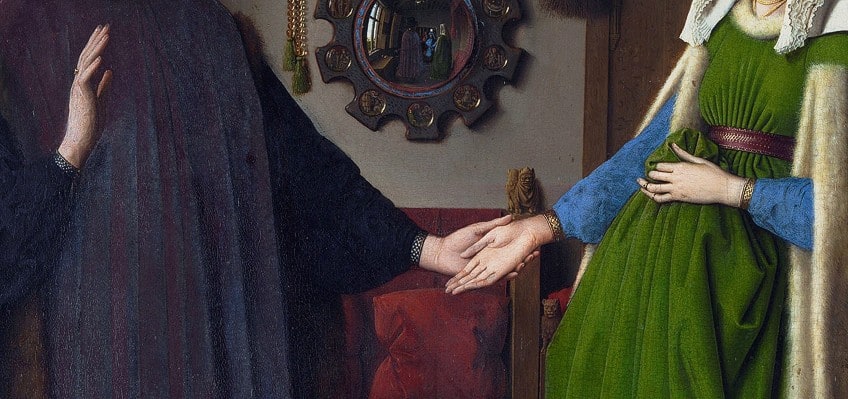
The candle is also burning on the left side, which is on the side of the man, and melted wax can be noticed on the right side, as if the candle already burnt out, which is on the right side. This has been thought to allude to the painting as being a commemorative depiction of the man’s wife who could have already died. The religious symbolism is extended to the rosary beads hanging to the left of the mirror and including the mirror, which has circular medallions around it depicting scenes from the story of the Passion of Christ.
The couple’s hand gesture, the man’s left palm facing up and the woman’s right hand, also palm up, resting in his left palm, have also been debated, for example, some scholars have suggested it indicates marriage between the two, could it have been for the Arnolfini wedding?
Others have suggested that it could symbolize an act of taking an oath or contract between the two for business purposes. Furthermore, the woman’s hair is held up, which was a sign of a married woman during the time they were painted. The position of the woman to the right, near the bed, and the man to the left, near the window, has also been thought to symbolize their gender roles within a marriage.
Formal Analysis: A Brief Compositional Overview
In the formal analysis below, you will read more about what Jan van Eyck depicted in The Arnolfini Portrait, which will include the couple as the central focal points and their surroundings. It will also describe the painting in more detail in terms of its stylistic composition according to how the art elements are utilized.
Subject Matter: Visual Description
The Arnolfini Portrait by Jan van Eyck depicts an interior scene with two people, a man on the left, assumed to be Giovanni di Nicolao di Arnolfini, and a woman on the right, assumed to be Costanza Trenta. They are both standing, facing us, the viewers, in the foreground. The man on the left is looking ahead of him, but not quite directly at us, the viewers. The woman has her head slightly tilted down with her gaze directed at the man. Both are connected by their hands that meet in the middle, between them.
The man’s left arm is held out, his palm facing up, and the woman’s right arm is held out and her hand is gently resting in the man’s palm, her palm is facing up too.
His right hand is raised up vertically, as if taking an oath according to some scholars. The woman’s left hand is holding up her dress’s fabric to just below her bust area. This crumpled appearance of her fabric and the positioning of her hand has led many to believe that she was pregnant, but reportedly, women during the Medieval times held their excess fabric in such a manner.
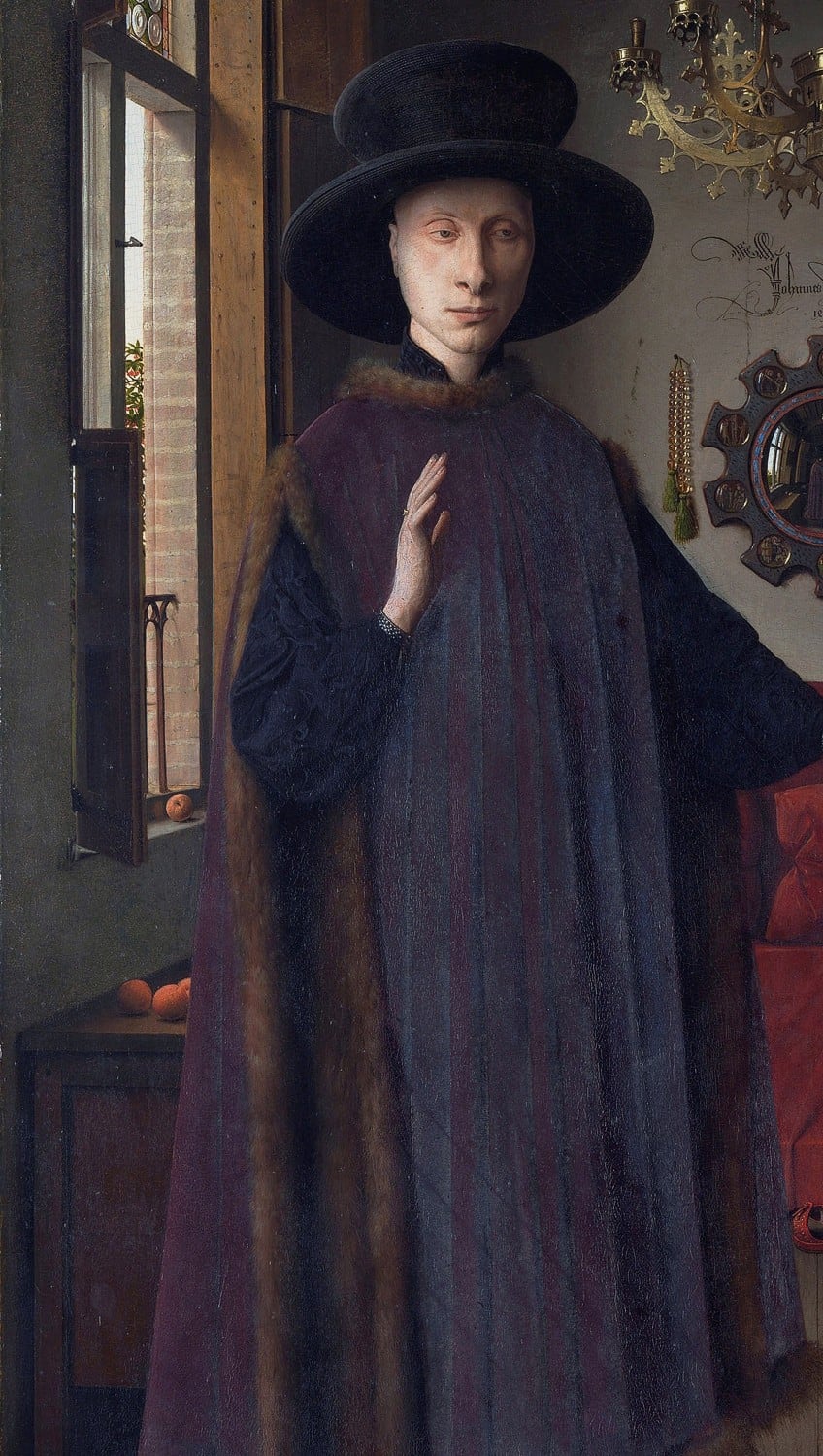
The man is wearing a dark brown tabard with fur trims and the fabric has been suggested to be either velvet or silk. A tabard was a coat typically worn during Medieval times. Under his tabard is a doublet, also believed to be silk, and he has silver patterned cuffs, which appear to be banded cuffs. He wears a large dark hat that is made of plaited straw. The woman’s green dress is described as a houppelande, which were long dress-like garments worn over undergowns. It is reportedly made of wool with fur trims around the bag sleeves. The houppelande has a long train that collects in the foreground of the composition.
Below the woman’s bag sleeves is a textured pattern on the houppelande’s fabric, which is known as the dagging technique.
A small part of the blue dress is visible at the bottom of the woman’s green houppelande. Additionally, the woman’s blue dress’s sleeves have gold embroidered cuff bands. She is also wearing an embroidered waistband. Her jewelry consists of a golden necklace that appears to be folded double around her neck and there is a ring on her left pinkie finger and left ring finger. On the woman’s head is a white linen headdress, which has five layers and falls below her shoulders. Her brunette hair is styled in what is known as cones.
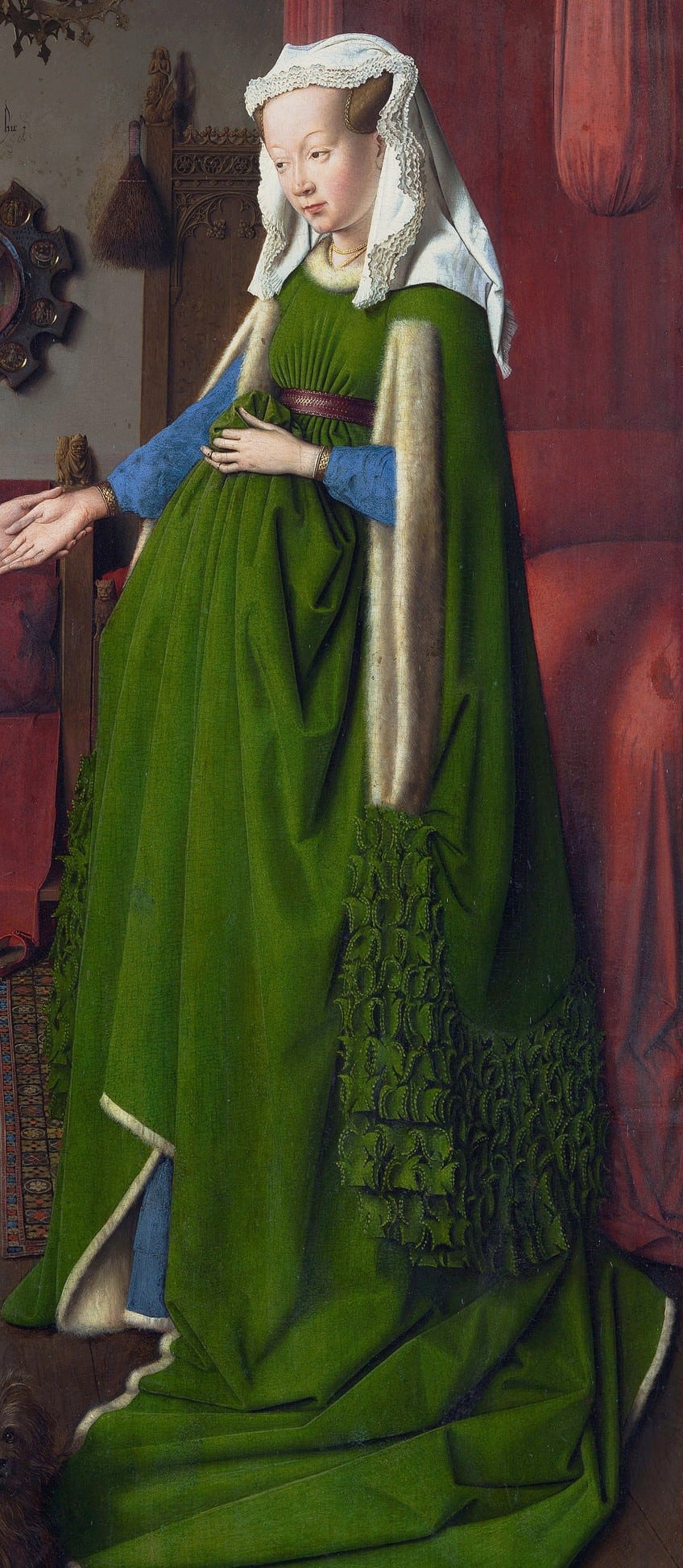
There is a small dog standing in the direct foreground, in between the two figures, also facing us. The breed of the dog is reportedly a Brussels Griffon. A pair of wooden overshoes, also known as pattens, are lying on the wooden floor in the lower left corner of the composition. The left side of the composition is composed of a window with opened shutters giving a sliver of a glimpse of the outside, revealing a blue sky and a cherry tree.
The top part of the window consists of beautiful patterned stained glass. There is an orange on the windowsill and right below the window are three more oranges visible to us on a wooden table/chest against the wall.
In the background, against the wall, is a wooden bench and a chair with a long backrest, which is not clear in our view. Both the bench and chair are covered by deep red fabric and there is a red cushion on the bench directly in our view. Additionally, both have intricately carved decorations on them. Hanging on the left side, on a hook, of the chair is what appears to be a straw duster. To the right of the composition, next to the chairs, is a bed, which is also covered in deep red fabric and the bedpost is as high as the ceiling. There is an oriental carpet next to the bed.
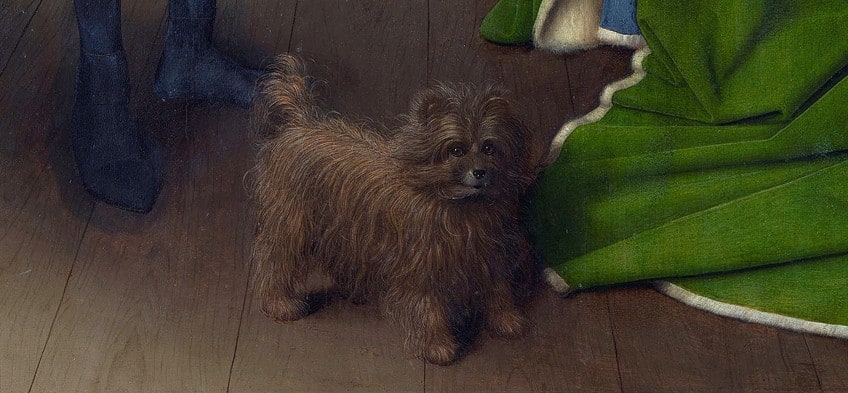
Above the chairs is a round mirror hanging on the wall with a convex glass reflecting the scene. The mirror reflects the couple but also reveals another two male figures appearing to be walking through a door. The one standing in front is dressed in blue and the one behind him is in red. Some believe one of the men was the artist, Jan van Eyck, depicting himself. Around the mirror are ten smaller medallions depicting scenes from the Passion of Christ. There is a rosary hanging to the left of the mirror and above the mirror is Jan van Eyck’s large signature stating, “Johannes de Eyck fuit hic. 1434”, which translates to “Jan van Eyck was here. 1434.
The ceiling consists of wooden strips and a large chandelier made of brass hangs behind the couple. The chandelier only has one burning candle in it on the left side and remnants of wax on the left side suggesting another candle that burnt out.
Color and Value
Jan van Eyck utilized a somewhat limited color palette in The Arnolfini Portrait. From deep reds, and oranges, to the brilliant green of the woman’s houppelande, to more neutral colors like blacks, browns, whites, and beiges. The composition is not overly bright, and the darker shades create a warmth in color temperature.

There are also natural light sources depicted emanating from the window to the left, which creates a subtle contrast of dark and light, further enhancing the mood of the composition. The woman also appears to be the focal point as she is wearing most of the colors, green and blue and the man is wearing dark colors.
Texture
Jan van Eyck utilized oil paints with his unique painting skills and reportedly his brushstrokes were applied with a level of looseness. The composition of The Arnolfini Portrait has smooth and fine brushstrokes, which creates more realism of the subject matter.
There is a rich array of implied textures.
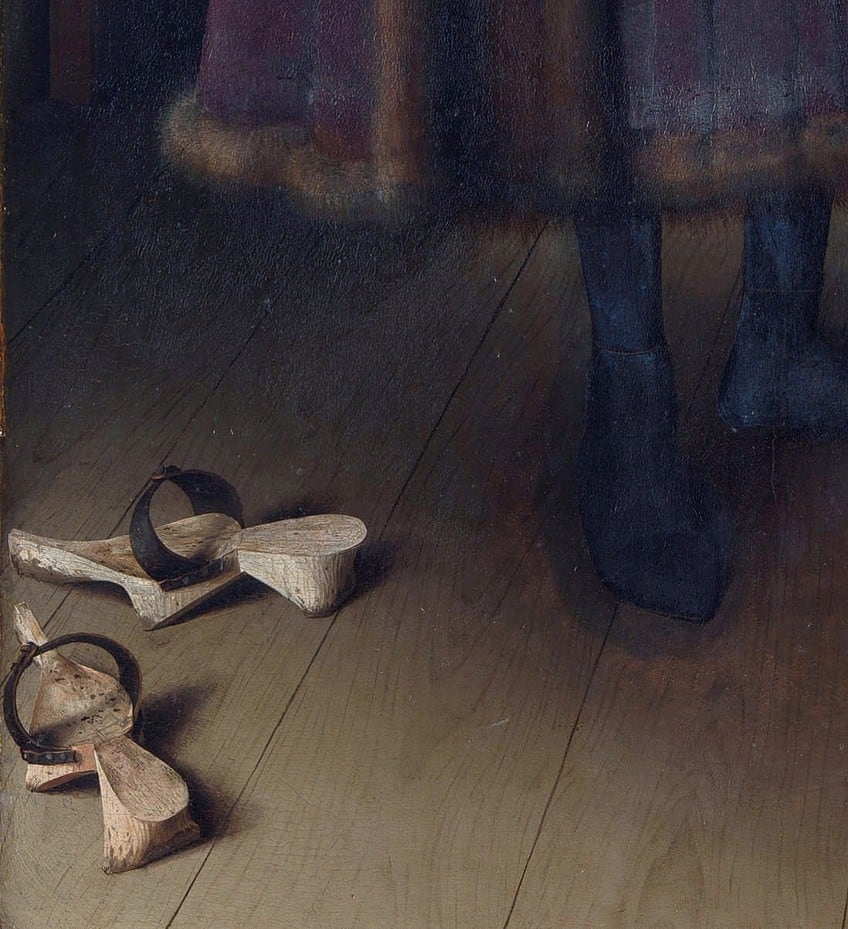
For example, the soft appearance of the fabrics, notably the fur trims on the figures’ clothing, or the harder textures of the wood of the floor and shoes. Other examples of implied texture include the smoothed and hard surface of the rosary beads in the background, including their glistening as the light reflects off them. The chandelier too appears illuminated in its metallic shine.
Line
There are a variety of types of lines in The Arnolfini Portrait by Jan van Eyck, all of which create a naturalistic composition. The more dominant lines include vertical and diagonals, for example, the vertical lines of the two standing figures and the folds in their garments, the man’s upright right hand, the floorboards, and the various vertical lines from the carpet, chair, bed, the cords of the hanging chandelier, and window to the left.
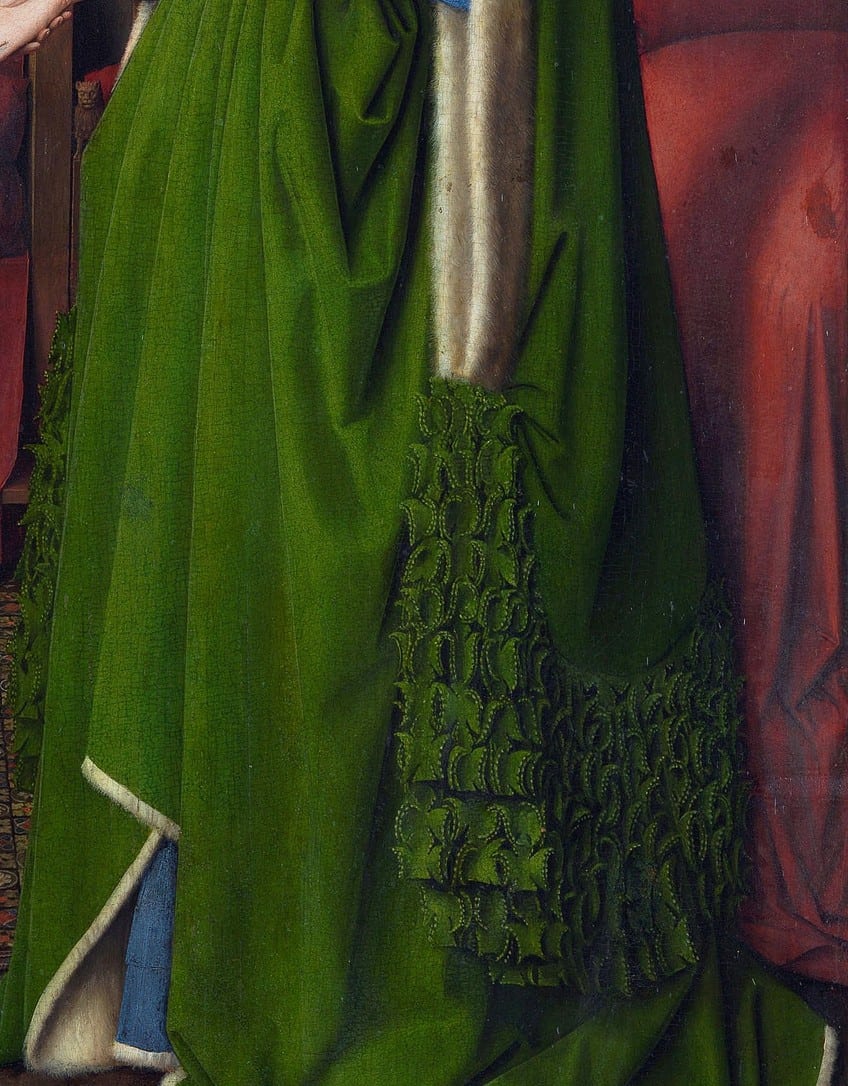
Diagonal lines are visible in the folds of the woman’s houppelande, the bed in the background, and the figure’s outstretched arms creating a curved V-shape between them, the latter are also described as directional lines. Some of the horizontal lines are in the chairs and folds in the red fabric on them in the background and the window to the left.
Shape and Form
The type of shapes and forms that occur in The Arnolfini Portrait by Jan van Eyck included naturalistic, otherwise also known as organic, which you will notice in real life. Examples of these include the spherical forms of the oranges, the circular shape of the mirror, and the more rectangular or square-like shapes of the window, chairs, and bed.
Irregular shapes include the chandelier and its myriad of curves. There are also patterned shapes of the carvings in the wood of the chair in the background and more of an irregular geometric shape created from the mirror’s edges.

Space
Jan van Eyck created a three-dimensional space, which depicts depth, in The Arnolfini Portrait. This was achieved through perspectival techniques like diminishing scale, for example, the background appears somewhat smaller in size compared to the foreground, where the two figures appear larger as the main focal points.

Additionally, the overlapping of the figures in the foreground with the objects in the background also creates a sense of spatial depth. However, although Jan van Eyck depicted a sense of depth, there is also a disproportion in how he placed the figures and items. The artist’s motives for this have been questioned.
A Portrait Brimming With Life
The Arnolfini Portrait by Jan van Eyck is a masterpiece of early Netherlandish Renaissance art and a true testament to the artist’s style of painting in such a realistic manner, giving the stark illusion of a real interior where the objects and people in it come to life in a whole new way. While this Jan van Eyck Arnolfini portrait analysis explored just a few of the primary details and ideas around its meaning and symbolism, there is a depth of knowledge and scholarly theories waiting to be explored further.
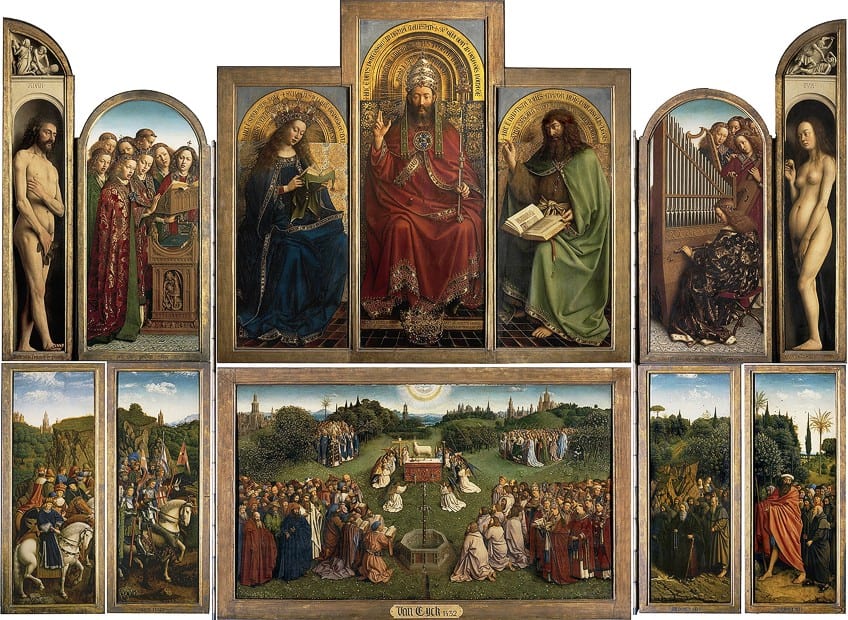
Whether it was to depict the Arnolfini wedding, their social status and wealth, commemorating the dead, or simply a painting of everyday life, The Arnolfini Portrait by Jan van Eyck was and still is an enigma of its time. Although this masterpiece of oil paints and subject matter is over 500 years old, it is still brimming with life to this day.
Frequently Asked Questions
The Arnolfini Portrait Is Part of Which Period in Art?
The Arnolfini Portrait (1434) by Jan van Eyck is from the Early Netherlandish and Northern Renaissance art movement. Jan van Eyck was famously known as the so-called Father of Oil Painting, and his artworks were distinguished by the level of realistic detail portrayed in them.
What Does the Dog in The Arnolfini Portrait Symbolize?
One of the commonly held interpretations of the dog in the foreground of The Arnolfini Portrait by Jan van Eyck is notably that of fidelity. Some interpretations have also been around lust or desire.
Where Is The Arnolfini Portrait Located?
Jan van Eyck’s The Arnolfini Portrait is housed at the National Gallery in London, in the United Kingdom. While the provenance of the painting is extensive, it was purchased by the gallery for 600 Guineas in 1842 from Colonel James Hay. He reportedly held an exhibition in 1841, of which the painting was a part.
Jordan Anthony is a Cape Town-based film photographer, curator, and arts writer. She holds a Bachelor of Art in Fine Arts from the University of the Witwatersrand, Johannesburg, where she explored themes like healing, identity, dreams, and intuitive creation in her Contemporary art practice. Jordan has collaborated with various local art institutions, including the KZNSA Gallery in Durban, the Turbine Art Fair, and the Wits Art Museum. Her photography focuses on abstract color manipulations, portraiture, candid shots, and urban landscapes. She’s intrigued by philosophy, memory, and esotericism, drawing inspiration from Surrealism, Fluxus, and ancient civilizations, as well as childhood influences and found objects. Jordan is working for artfilemagazine since 2022 and writes blog posts about art history and photography.
Learn more about Jordan Anthony and about us.
Cite this Article
Jordan, Anthony, ““The Arnolfini Portrait” by Jan van Eyck – A Mirror of Mastery.” artfilemagazine – Your Online Art Source. November 10, 2023. URL: https://artfilemagazine.com/the-arnolfini-portrait-by-jan-van-eyck/
Anthony, J. (2023, 10 November). “The Arnolfini Portrait” by Jan van Eyck – A Mirror of Mastery. artfilemagazine – Your Online Art Source. https://artfilemagazine.com/the-arnolfini-portrait-by-jan-van-eyck/
Anthony, Jordan. ““The Arnolfini Portrait” by Jan van Eyck – A Mirror of Mastery.” artfilemagazine – Your Online Art Source, November 10, 2023. https://artfilemagazine.com/the-arnolfini-portrait-by-jan-van-eyck/.



